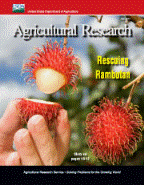United States Department of Agriculture: Agricultural Research Service, Lincoln, Nebraska

Agricultural Research Magazine
Date of this Version
7-2013
Document Type
Article
Citation
Agricultural Research July 2013.
Abstract
In Oregon, western juniper trees are expanding their range, pushing out other plant species, reducing sagebrush habitat and livestock forage, and at times fueling catastrophic wildfires. During some of these conflagrations, fires burn even hotter because more wood is available to feed the flames—a cause-and-effect that in turn lengthens the time that temperatures remain elevated at fire-stricken sites.
To help streamline efforts to manage invasive trees, Agricultural Research Service rangeland scientists Kirk Davies and Matt Madsen are investigating ways of combining aerial photography and computer programs to quickly identify and measure affected areas. These tools could save time and money for land managers tasked with protecting sagebrush ecosystems and controlling invasive vegetation.
Scouting for Western Juniper
Davies and Madsen, who work at the Eastern Oregon Agricultural Research Center in Burns, Oregon, led studies on using National Agricultural Imagery Program (NAIP) high-resolution aerial images to estimate western juniper cover. A related part of the project included exploring the relationships between cover of mature stands of juniper and site characteristics that influence soil moisture and temperature.
Working at a 30,500-acre site in Idaho, they collected information about juniper distribution and then used this data for “training” image software to identify juniper on the NAIP images. Using this calibrated approach—called “feature extraction”— the team identified juniper with an overall accuracy rate of 92 percent. For instance, the NAIP/software combination calculated that 26.8 percent of one site was covered with juniper; initial ground scouting had determined the coverage to be 24.7 percent.
Included in
Agriculture Commons, Animal Sciences Commons, Food Science Commons, Plant Sciences Commons

